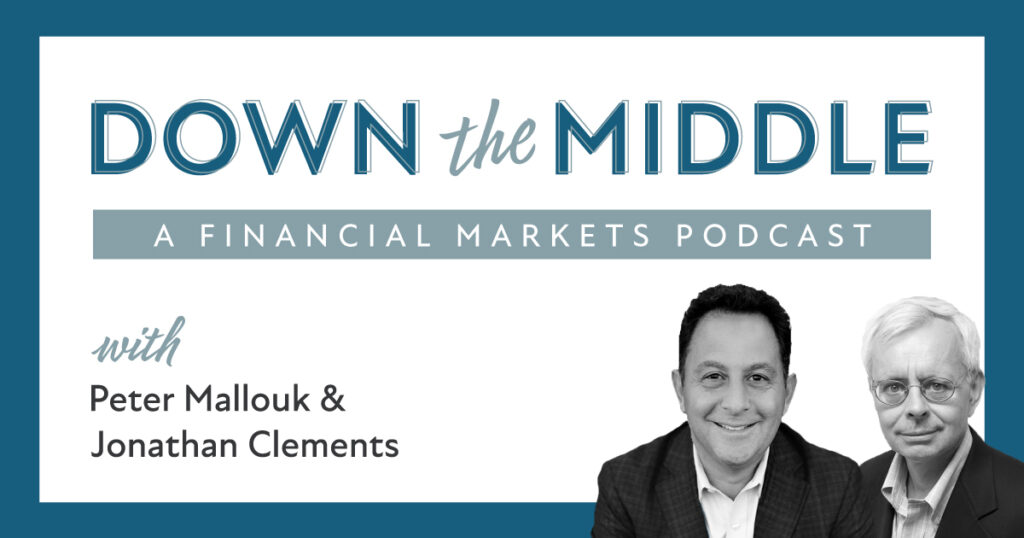This month, Peter Mallouk and Jonathan Clements explain how the debt ceiling came to be — as well as the likely consequences of a possible debt default — before Peter gives his prediction for how events will unfold. Plus, learn two things you can do to make things easier on your loved ones after your passing.
Hosted by Creative Planning Director of Financial Education, Jonathan Clements, and President, Peter Mallouk, this podcast takes a closer look into topics that affect investors. Included are in-depth discussions on financial planning issues, the economy and the markets. Plus, you won’t want to miss each of their monthly tips!
Important Legal Disclosure:
creativeplanning.com/important-disclosure-information/
Have questions or topic suggestions?
Email us @ podcasts@creativeplanning.com
Transcript:
Jonathan Clements: This is Jonathan Clements, Director of Financial Education for Creative Planning. With me is Peter Mallouk, President of the firm, and we are Down the Middle. In Washington DC, where waiting until the last minute is a favorite pastime, we’re now just days away from a potential government bond default, unless, that is, Congress votes to raise the debt ceiling. As things stand, Republicans are demanding spending cuts while the White House is offering a spending freeze. So Peter, how damaging would a government bond default be?
Peter Mallouk: Well, it would be absolutely devastating but extremely unlikely. So I’m just going to go back and explain what the debt ceiling is, how it started, and give some context to our listeners. So there was a time a long, long, long time ago where the U.S. actually took in certain amount of money and spent a certain amount of money. It operated like a normal budget, right? It didn’t run big deficits. But in 1917, as we were approaching entering World War I, no one wanted to pay for that war. They were worried about going into debt. And so this concept of, “Hey, okay, well let’s go into the war. Let’s have debt, but there’s going to be a limit on how much debt we’ll have.” That was the first debt ceiling. Congress basically agreed, passed a law, “This is how much we’re going to allow the country to go into debt.”
From then until now, the United States has been like a kid with a credit card, right? Running $1 trillion deficits, meaning the money we collect from taxes is not enough to cover our spending, and we go $1 trillion backwards every year because of that. So today the national debt is probably 31.5 trillion or so and rising rapidly. Now because we have this annual deficit, we keep getting closer and closer to the new debt ceiling that Congress has enacted. It’s becoming a spiraling problem because a lot of our expenses are programs that continue like Social Security, Medicare and so on, and they expand and they grow even faster than inflation in some instances and also because a big part of the expense is the interest we’re paying on all of the 31.5 trillion we have. It’s like a credit card. It’s reverse compounding. We’ve just got more and more interest we’re paying. It’s becoming a bigger and bigger part, soon to be the largest part, of what we’re spending.
So this is the recurring problem we have. And really both parties have had problems with the debt ceiling. They just like to spend money on different things. So 49 times the debt ceiling has been raised when a Republican was president, 29 times it’s been raised when a Democrat was president. This happens all the time. It’s always been raised. The U.S. has never defaulted.
So now to your question, what happens if we actually default? So all this money we’ve borrowed, this 31.5 trillion to pay for all of the things that we do, whether it’s Social Security and Medicare or the interest on our debt or defense spending, wars, whatever, we have to borrow that money from people. So we’ve borrowed from individuals, they loan us money in the form of treasury bonds or other countries like China, or corporations, they all loan money to the United States. The United States pays the lowest interest rate in the world because it’s considered the safest bet in the world. If you loan your money to the federal government, it’s actually considered risk-free. Like in other words, the odds you won’t get paid back are zero. There’s no other company/country in the world that has that kind of confidence.
So let’s say that we don’t raise the debt ceiling and we can’t make that payment on the bonds that we owe, we can’t make that credit card payment. There’s a lot of debate about what would happen, but I think a couple things for certain would happen. One, we’d be downgraded by all the bond agencies would say, “Hey, this is no longer the very safest thing in the world. Or even if it is the safest thing in the world, it’s still not as totally safe as we thought it was.” Our cost of borrowing would go up. Other people and countries and companies would demand a higher interest rate to loan us money in the future. And you’d see a negative impact of a spiraling economy, higher unemployment, the stock market would go down, and so on. So the repercussions are very, very, very severe, which is why it is so unlikely to happen.
Jonathan: Even though we have had this sort of political drama in the past, investors in Washington today may not take that much comfort from the fact that we’ve always got through this before. My assumption is that a deal will be struck because it always has been in the past. But do you think there’s any reason, Peter, to think that it’ll be different this time?
Peter: Well, they started out so far apart. President Biden basically said, “I’m not doing anything except a no strings attached increase. You have to let me raise the ceiling and I’m not giving up anything to do that.” The Republicans, led by McCarthy, basically said, “Hey, look, we’ll raise the debt ceiling for you, but you have to promise we’re going to cut federal spending by 14% over the next decade.” So they started pretty far apart. Now they’re at least talking to each other. So they’ve both come off of those positions. I think this is really a symptom of incentives and the political system that we have. When you have only two parties, there’s not a middle party, like a lot of countries have a middle party, it’s able to pull in these two parties from extreme positions on not just this, but any issue. We don’t have that, right?
So we have this polarization. So if you think about it, these are political animals, McCarthy and Biden are political animals. And if with plenty of time left on the clock they struck a deal, both of them would be losers. So Speaker McCarthy would’ve to go back to the Republicans and they’d say, “You didn’t fight hard enough,” and he’d go, “I did everything I could.” And they’re like, “No, you didn’t. We had three weeks left and we could have got more.” And President Biden would go back to his supporters and say, “I’m sorry, I had the give in on some cuts in the future.” And they’d say, “You didn’t fight hard enough.” So what they need for it to be in their own best interest to reach a deal is they need to get out of this window where they’ll be the bad guy for settling and instead be the heroes that saved the day at the last second because the U.S. was going to default in a couple of days.
And so that’s what’s going to happen. We’re going to have an agreement at the very last second, just a couple days before we default, because that’s the only moment where it will be in their best interest to reach a resolution.
Jonathan: So despite all the drama, in fact, the stock market has held up reasonably well. In fact, the stock market bottomed back in October, and since then the S&P 500 is up roughly 15%. Peter, do you think that once the debt ceiling is raised, that’ll be the trigger for the next bull market or are investors looking for something else?
Peter: I don’t think it’ll impact the stock market much, maybe for one day a little bit. And the reason I don’t think that is, to your point, the stock market’s not really phased by this. The stock market is pricing in, if not 0%, very, very, very close to 0% chance of a default. And the bond market’s pricing in the same. If there was a 3% chance of default, the stock market and bond market would be absolutely destroyed right now. And that’s why I think we’re going to see a little upside when it gets resolved. A little bit, but it’s not going to be significant. We’ll move on to other issues.
Jonathan: All right, Peter, that’s it for the debt ceiling this time around, and it’s time for our financial wellness tip of the month. What have you got for me, Peter?
Peter: So for me, as Creative Planning clients know, we’re really big on getting our clients organized, making sure they know where all of their important records are. I would just encourage all of our listeners: have a place where your family or beneficiaries know how to access your passwords. So we see this a lot where people can get to all their important records, but they can’t get their social media logins and their bank logins and all of these things that the family really needs to be able to handle affairs in the event of incapacity or wind things up in the event of a death. So make an effort to get all of that in the hands of a loved one as well. How about you, Jonathan?
Jonathan: So my financial wellness tip of the month is related to that, which is to throw out unnecessary old financial records. You know, I personally keep seven years of tax returns and the supporting materials. I keep the latest copy of my various insurance policies. I keep cost basis information from my house, and that’s pretty much it. I mean, for instance, I don’t bother anymore keeping cost basis information from my investments because my brokerage firm provides all of that. Of course, everybody’s financial situation is going to be different and what you should keep will vary, still keep this one point in mind. If you go under the next bus, your family will assume that everything that’s in the filing cabinet is of equal importance. And all those old unnecessary financial records could make their lives much more difficult in the months after your death.
All right, Peter. So that’s it for this month. This is Jonathan Clemens, Director of Financial Education for Creative Planning. I’ve been talking to Peter Mallouk, the President of firm, and we are Down the Middle.
Disclosure: This show is designed to be informational in nature and does not constitute investment advice. Different types of investments involve varying degrees of risk and there can be no assurance that the future performance of any specific investment or investment strategy, including those discussed on this show, will be profitable or equal any historical performance levels.





